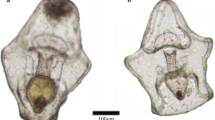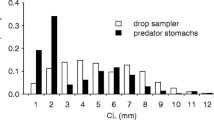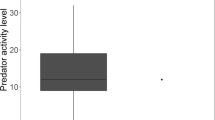Abstract
Predation can play an important role in the recruitment dynamics of fishes with intensity regulated by behavioral (i.e., prey selectivity) and/or environmental conditions that may be especially important for rare or endangered fishes. We conducted laboratory experiments to quantify prey selection and capture efficiency by three predators employing distinct foraging strategies: pelagic piscivore (walleye Sander vitreus); benthic piscivore (flathead catfish Pylodictis olivaris) and generalist predator (smallmouth bass Micropterus dolomieu) foraging on two size classes of age-0 pallid sturgeon: large (75–100 mm fork length [FL]) and small (40–50 mm FL). Experiments at high (> 70 nephalometric turbidity units [NTU]) and low (< 5 NTU) turbidity for each predator were conducted with high and low densities of pallid sturgeon and contrasting densities of an alternative prey, fathead minnow Pimephales promelas. Predator behaviors (strikes, captures, and consumed prey) were also quantified for each prey type. Walleye and smallmouth bass negatively selected pallid sturgeon (Chesson’s α = 0.04–0.1) across all treatments, indicating low relative vulnerability to predation. Relative vulnerability to predation by flathead catfish was moderate for small pallid sturgeon (α = 0.44, neutral selection), but low for large pallid sturgeon (α = 0.11, negative selection). Turbidity (up to 100 NTU) did not affect pallid sturgeon vulnerability, even at low density of alternative prey. Age-0 pallid sturgeon were easily captured by all predators, but were rarely consumed, suggesting mechanisms other than predator capture efficiency govern sturgeon predation vulnerability.



Similar content being viewed by others

References
Abrahams MV (1995) The interaction between antipredator behavior and antipredator morphology: experiments with fathead minnow and brook sticklebacks. Can J Zool 73:2209–2215
Abrahams MV, Kattenfeld MG (1997) The role of turbidity as a constraint on predator–prey interactions in aquatic environments. Behav Ecol Sociobio 40:169–174
Adams SR, Adams GL, Parsons GR (2003) Critical swimming speed and behavior of juvenile shovelnose sturgeon and pallid sturgeon. Trans Am Fish Soc 132:392–397
Bemis WE, Findeis EK (1994) The sturgeons’ plight. Nat Geosci 370:602
Bergman HL, Boelter AM, Parady K, Fleming C, Keevin T, Latka DC, Korschgen C, Galat DL, Hill T, Jordan G, Krentz S, Nelson-Stastny W, Olson M, Mestl GE, Rouse K, Berkley J (2008) Research needs and management strategies for pallid sturgeon recovery. Proceedings of a workshop held July 31–August 2, 2007, St. Louis, Missouri. Final report to the U.S. Army Corps of Engineers. William D. Ruckelshaus Institute of Environment and Natural Resources, University of Wyoming, Laramie.
Berry CR Jr, Young B (2004) Fishes of the Missouri National Recreational River. South Dakota and Nebraska. Great Plains Res 14:89–114
Berry CR Jr, Wildhaber ML, Galat DL (2004) Fish distribution and abundance. Volume 3. Population structure and habitat use of benthic fishes along the Missouri and lower Yellowstone Rivers. U. S. Geological Survey, Cooperative Research Units, South Dakota State University, Brookings.
Birstein VJ, Bemis WE, Waldman JR (1997) The threatened status of acipenseriform species: a summary. Environ Biol Fishes 48:427–435
Boley RM, Heist EJ (2011) Larval surveys indicate low levels of endangered pallid sturgeon reproduction in the middle Mississippi River. Trans Am Fish Soc 140:1604–1612
Breck JE (1993) Foraging theory and piscivorous fish, are forage fish just big zooplankton? Trans Am Fish Soc 122:902–911
Brower LP, Moffitt CM (1974) Palatability dynamics of cardenolides in the monarch butterfly. Nature 249:280–283
Buckmeier DL, Betsill RK, Schlechte JW (2005) Initial predation of stocked fingerling largemouth bass in a Texas reservoir and implications for improving stocking efficiency. N Am J Fish Man 25:652–659
Campbell EA (1998) Predation by small walleye on yellow perch: effects of prey size distribution. Trans Am Fish Soc 127:588–597
Caroffino DC, Sutton TM, Elliot RF, Donofrio MC (2010) Predation on early life stages of lake sturgeon in the Peshtigo River, Wisconsin. Trans Am Fish Soc 139:1846–1856
Carter MW, Shoup DE, Dettmers JM, Wahl DH (2010) Effects of turbidity and cover on prey selectivity of adult smallmouth bass. Trans Am Fish Soc 139:353–361
Chesson J (1983) The estimation and analysis of preference and its relationship to foraging models. Ecology 64:1297–1304
DeLonay AJ, Jacobson RB, Papoulias DM, Simpkins DG, Wildhaber ML, Reuter JM, Bonnot, TW, Chojnacki KA, Korschgen CE, Mestl GE, Mac MJ (2009) Ecological requirements for pallid sturgeon reproduction and recruitment in the Lower Missouri River: A research synthesis 2005–08: U.S. Geological Survey Scientific Investigations Report 2009–5201, 59 p.
Demers E, McKinley RS, Weatherley AH, McQueen DJ (1996) Activity patterns of largemouth and smallmouth bass determined with electromyogram biotelemetry. Trans Am Fish Soc 125:434–439
Eder, B. and K. Steffensen. 2010. 2009 Annual Report Pallid Sturgeon Population Assessment and Associated Fish Community Monitoring for the Missouri River: Segment 8. Prepared for the U.S. Army Corps of Engineers – Northwest Division. Nebraska Game and Parks Commission, Lincoln. Available at: http://www.moriverrecovery.org/mrrp/f?p=136:155:914195080513601::NO::PIS_ID:44 March 2013
Flowers JH, Bonvechio TF, Peterson DL (2011) Observation of Atlantic sturgeon predation by a flathead catfish. Trans Am Fish Soc 140:250–252
French WE, Graeb BDS, Chipps SR, Bertrand KN, Selch TM, Klumb RA (2010) Vulnerability of age-0 pallid sturgeon Scaphirhynchus albus to fish predation. J Appl Ichthyol 26:6–10
Fritts AL, Pearsons TN (2006) Effects of predation by nonnative smallmouth bass on native salmonid prey: the role of predator and prey size. Trans Am Fish Soc 135:853–860
Gadomski DM, Parsley MJ (2005a) Effects of turbidity, light level, and cover on predation of white sturgeon larvae by prickly sculpins. Trans Am Fish Soc 134:369–374
Gadomski DM, Parsley MJ (2005b) Vulnerability of young white sturgeon, Acipenser transmontanus, to predation in the presence of alternative prey. Environ Biol Fishes 74:389–396
Gadomski DM, Parsley MJ (2005c) Laboratory studies on the vulnerability of young white sturgeon to predation. N Am J Fish Manag 25:667–674
Gladstone W (1987) The eggs and larvae of the sharpnose pufferfish Canthigaster valentine are unpalatable to other reef fishes. Copeia 1:227–230
Gross MP (1978) Natural selection by predators on the defensive apparatus of the three-spined stickleback, Gasterosteus aculeatus. Can J Zool 56:398–413
Gunzburger MS, Travis J (2005) Critical literature review of the evidence for unpalatability of amphibian eggs and larvae. J Herpetol 39:47–571
Haddix T., J. Hunziker, and L. Holte. 2010a. 2009. Annual Report: Pallid Sturgeon Population Assessment and Associated Fish Community Monitoring for the Missouri River: Segment 2. Prepared for the U.S. Army Corps of Engineers—Missouri River Recovery Program. Montana Department of Fish, Wildlife, and Parks, Fort Peck. Available at: http://www.moriverrecovery.org/mrrp/f?p=136:155:914195080513601::NO::PIS_ID:44 March 2013
Hadley GL, Rotella JJ (2009) Upper basin pallid sturgeon survival estimation project final report. Montana State University, Bozeman
Harvey CJ, Kareiva PM (2005) Community context and the influence of non-indigenous species on juvenile salmon survival in a Columbia River reservoir. Biol Invas 7:651–663
Hecht T, Van der Lingen CD (1992) Turbidity-induced changes in feeding strategies of fish in estuaries. S Afr J Zool 27:95–107
Heist EJ, Saltzgiver M, Geltz J, Hedrick P (2009) Genetic management plan for captive-reared pallid sturgeon broodstock Contract No. 08-UGPR-56 U.S. Department of Energy Western Area Power Administration, Billings, Montana.
Henderson NJ, Letcher BH (2003) Predation on stocked Atlantic salmon (Salmo salar) fry. Can J Fish Aquat Sci 60:32–42
Hero J, Magnusson WE, Rocha CF, Catterall DCP (2001) Antipredator defenses influence the distribution of amphibian prey species in the central Amazon rainforest. Biotropica 33:131–141
Hesse LW, Bliss QP, Zuerlein GJ (1982) Chapter 9 Some aspects of the ecology of adult fishes in the channelized Missouri River with special reference to the effects of two nucleaer power generating stations. In: Hesse LW, Hergenrader GL, Lewis HS, Reetz SD, Schlesigner (eds) The middle Missouri river. The Missouri River Study Group, Norfolk, pp 225–273
Huenemann T (2013) Central Lowlands and Interior Highlands pallid sturgeon spawning and stocking summary 1992–2012. Prepared for the Middle Basin Pallid Sturgeon Workgroup. Nebraska Game and Parks Commission, Lincoln
Houde DE (1989) Subtleties and episodes in the early life of fishes. J Fish Biol 35:29–38
Johnson JE, Pardew MG, Lyttle MM (1993) Predator recognition and avoidance by larval razorback sucker and northern hog sucker. Trans Am Fish Soc 122:1139–1145
Kelso JRM (2006) Diel rhythm in activity of walleye, Stizostedion vitreum vitreum. J Fish Biol 12:593–599
Kempinger JJ (1988) Spawning and early life history of lake sturgeon in the Lake Winnebago system, Wisconsin. 11th Annual larval fish conference. Edited by: Hoyt, R. D. pp.110–122. Bethesda, Maryland: American Fisheries Society. Symposium 5
Krentz S, Holm R, Bollig H, Dean J, Rhodes M, Hendrix D, Heidrich G, Krise B (2005) Pallid sturgeon spawning and stocking summary report. 1992–2004. United States Fish and Wildlife Service report. Missour River Fish and Wildlife Conservation Office. Bismarck, North Dakota. (available at: http://www.fws.gov/moriver/)
Layher WG, Boles RJ (1980) Food habits of flathead catfish, Pylodictis olivaris (Rafinesque), in relation to length and season in a large Kansas reservoir. Trans Kans Acad Sci 83:200–214
Peckarsky BL, Kerans BL, Taylor BW, McIntosh AR (2008) Predator effects on prey population dynamics in open systems. Oecologia 156:431–440
Pflieger WL (1997) The Fishes of Missouri. The conservation commission of the state of Missouri, Jefferson City
Pohlmann K, Atema JA, Breithaupt T (2004) The importance of the lateral line in nocturnal predation of piscivorous catfish. J Exp Biol 207:2971–2978
Rice JA, Crowder LB, Holey ME (1987) Exploration of mechanisms regulating larval survival in Lake Michigan bloater: a recruitment analysis based on characteristics of individual larvae. Trans Am Fish Soc 116:703–718
Ricker WE (1975) Computation and interpretation of biological statistics of fish populations. Bull Fish Res Board Can 191:382
Rosenthal H, Pourkazemi M, Bruch R (2006) The 5th international symposium on sturgeons: a conference with major emphasis on conservation, environmental mitigation and sustainable use of the sturgeon resources. J Appl Ichthy 22:1–4
Ryder RA (1977) Effects of ambient light variations on behavior of yearling, subadult, and adult walleye (Stizostedion vitreum vitreum). J Fish Res Board Can 34:1481–1491
Schlosser IJ, Ebel KK (1989) Effects of flow regime and cyprinid predation on a headwater stream. Ecol Monogr 59:41–57
Sih A (1987) Prey refuges and predator–prey stability. Theorhet Pop Biol 31:1–12
Shoup DE, Wahl DH (2009) The effects of turbidity on prey selection by piscivorous largemouth bass. Trans Am Fish Soc 138:1018–1027
Shuman, D.A., R. A. Klumb, and G. A. Wanner. 2010. 2009 Annual report- Pallid sturgeon population assessment and associated fish community monitoring for the Missouri River: Segments 5 and 6. Prepared for the U.S. Army Corps of Engineers-Missouri River Recovery Program. U.S. Fish and Wildlife Service Great Plains Fish and Wildlife Conservation Office, Pierre, South Dakota. http://www.moriverrecovery.org/mrrp/f?p=136:155:914195080513601::NO::PIS_ID:44 March 2013
Snyder DE (2000) Identification of sturgeon larvae collected from the Missouri River at Lisbon Bottoms, MO, 13 August 1998 and 23 July 1999. Larval Fish Laboratory, Department of Fishery and Wildlife Biology, Colorado State University, Fort Collins.
Snyder DE (2002) Pallid and shovelnose sturgeon larvae-morphological description and identification. J Appl Ichthyol 18:240–265
Spindler BD, Chipps SR, Klumb RA, Graeb BDS, Wimberly MC (2012) Habitat and prey availability attributes associated with juvenile and early adult pallid sturgeon occurrence in the Missouri River, USA. Endangered Species Res 16:225–234
Steffensen, K. 2010. 2009 Annual Report: Pallid Sturgeon Population Assessment and Associated Fish Community Monitoring for the Missouri River: Segment 9. Prepared for the U.S. Army Corps of Engineers – Northwest Division. Nebraska Game and Parks Commission, Lincoln. http://www.moriverrecovery.org/mrrp/f?p=136:155:914195080513601::NO::PIS_ID:44 March 2013
Steffensen KD, Powell LA, Koch JD (2010) Assessment of Hatchery-Reared Pallid Sturgeon survival in the lower Missouri River. N Am J Fish Manag 30:671–678
Stukel, S., J. Kral, and S. LaBay. 2010. 2009 Annual Report: Pallid Sturgeon Population Assessment and Associated Fish Community Monitoring for the Missouri River: Segment 7. Prepared for the U.S. Army Corps of Engineers – Northwest Division. South Dakota Department of Game, Fish and Parks, Yankton. Available at: http://www.moriverrecovery.org/mrrp/f?p=136:155:914195080513601::NO::PIS_ID:44 March 2013
U.S. Fish and Wildlife Service (2008) Pallid sturgeon (Scaphirhynchus albus) range-wide stocking and augmentation plan. Prepared by the Pallid Sturgeon Recovery Team for the U. S. Fish and Wildlife Service, Region 6. Denver, Colorado.
U.S. Fish and Wildlife Service (1990) Endangered and threatened wildlife and plants determination of endangered status for the pallid sturgeon. Fed Regist 55:36641–36647
Wilson R., E. Nelson, and Z. Sandness. 2010. 2009 Annual Report: Pallid Sturgeon Population Assessment and Associated Fish Community Monitoring for the Missouri River: Segment 4. Prepared for the U.S. Army Corps of Engineers – Northwest Division. U. S. Fish and Wildlife Service, Missouri River Fish and Wildlife Conservation Office, Bismarck, North Dakota. Available at:http://www.moriverrecovery.org/mrrp/f?p=136:155:914195080513601::NO::PIS_ID:44 March 2013
Webb PW (1986) Effect of body form and response threshold on the vulnerability of four species of teleost prey attacked by largemouth bass Micropterus salmoides. Can J Fish Aquat Sci 43:763–771
Werner EE, Hall DJ (1974) Optimal foraging and the size selection of prey by the bluegill sunfish Lempomis macrochirus. Ecology 55:1042–1052
Wilmers CC, Post E, Peterson RO, Vucetich JA (2006) Predator disease out-break modulates top-down, bottom-up and climatic effects on herbivore population dynamics. Ecol Lett 9:383–389
Acknowledgments
We thank D. Spengler, T. Schaeffer, and D. Hanisch for assistance in the laboratory. The US Fish and Wildlife Service Gavins Point National Fish Hatchery, Yankton, SD supplied pallid sturgeon for use in these experiments as well as logistical support. C. Longhenry and South Dakota Department of Game, Fish, and Parks assisted with obtaining flathead catfish from Lewis and Clark Lake. Funding for this project was provided by the U. S. Army Corp of Engineers. Additional funding was provided by the U.S. Fish and Wildlife Service. All animals used in this study were reared according to animal use and care guidelines established by South Dakota State University (Animal Welfare Assurance no. A3958-01). The South Dakota Cooperative Fish and Wildlife Research Unit is jointly sponsored by the U.S. Geological Survey, South Dakota Department of Game, Fish and Parks, South Dakota State University, the Wildlife Management Institute, and the U.S. Fish and Wildlife Service. Any use of trade names is for descriptive purposes only and does not imply endorsement by the U.S. Government.
Author information
Authors and Affiliations
Corresponding author
Rights and permissions
About this article
Cite this article
French, W.E., Graeb, B.D.S., Chipps, S.R. et al. Vulnerability of age-0 pallid sturgeon Scaphirhynchus albus to predation; effects of predator type, turbidity, body size, and prey density. Environ Biol Fish 97, 635–646 (2014). https://doi.org/10.1007/s10641-013-0166-y
Received:
Accepted:
Published:
Issue Date:
DOI: https://doi.org/10.1007/s10641-013-0166-y



